Hybrid Electric Vehicles: A Review of Existing Configurations and Thermodynamic Cycles
Abstract
1. Introduction
2. Most Typical Configurations for HEVs
- High performance.
- Low pollutant emissions from fossil fuels.
- Enough energy storage on board to cover adequate autonomy.
- Sufficient power generation to supply the various requirements in the driving and behavior of a vehicle.
2.1. Classification by Vehicle Hybridization Level
- Hybridization of the propulsion system: this classification comprises those vehicles that have at the same time an electric traction system and another based on a heat engine (usually combustion or compression engines). Therefore, both systems have the ability, either independently or in combination, to propel the automobile. Propulsion system hybridization vehicles are composed of a heat and electric motor, but the latter is only used for starting and keeping the vehicle at low speeds over short distances.
- Hybridization of the power supply system: in this case, the vehicles have more than one type of energy system, which could be either production or storage, being at least one of them purely electric. Intuitively, this configuration must count with at least an electric motor. The hybridization system with power supply combines an electrical system and a fuel that serves to increase the autonomy, but the tractor system will be electric, being the function of the heat engine to recharge the batteries when they are running out. This model is also valid for fuel-cell electric vehicles, in which the electric energy is produced through fuel cells that convert hydrogen to electrical energy [42].
2.1.1. Micro-Hybrid
2.1.2. Mild-Hybrid
2.1.3. Full-Hybrid
2.1.4. Plug-in-Hybrid
2.2. Classification by Architecture
2.2.1. Series Configuration
2.2.2. Parallel Configuration
2.2.3. Mixed Configuration
2.2.4. Summary of Architectures for HEVs
3. Thermodynamic Models for HEVs
3.1. Nomenclature
- Heat
- Work
- Temperature
- Entropy
- Pressure
- Volume
- Thermal efficiency
- Energy
- Mass flow
3.2. Otto Cycle
- Adiabatic compression (1–2): compression of the working fluid, the piston has to perform the work .
- Contribution of heat at constant volume (2–3): instantaneous introduction of the heat is provided.
- Adiabatic expansion (3–4): expansion, which is corresponding to the work, performed by the working fluid.
- Extraction of heat at constant volume (4–5): instantaneous extraction of heat.
- Heat loss through the walls, caused by the need to have a cooling system for the ignition engines organs.
- Need to anticipate ignition with respect to death point, because combustion is not instantaneous and a certain time is needed.
- Exhaust opening advance, due to the inertia of the valves and gas masses.
- Loss of pumping work during the exhaust and intake stroke.
3.3. Atkinson Cycle
3.4. Miller Cycle
3.5. Finite Time Thermodynamics
4. Conclusions
Author Contributions
Funding
Institutional Review Board Statement
Informed Consent Statement
Data Availability Statement
Acknowledgments
Conflicts of Interest
References
- Choma, E.F.; Evans, J.S.; Hammitt, J.K.; Gómez-Ibáñez, J.A.; Spengler, J.D. Assessing the health impacts of electric vehicles through air pollution in the United States. Environ. Int. 2020, 144, 106015. [Google Scholar] [CrossRef]
- Cárcel-Carrasco, J.; Pascual-Guillamón, M.; Salas-Vicente, F. Analysis on the Effect of the Mobility of Combustion Vehicles in the Environment of Cities and the Improvement in Air Pollution in Europe: A Vision for the Awareness of Citizens and Policy Makers. Land 2021, 10, 184. [Google Scholar] [CrossRef]
- Yang, X.; Lin, W.Q.; Gong, R.X.; Zhu, M.Z.; Springer, C. Transport decarbonization in big cities: An integrated environmental co-benefit analysis of vehicles purchases quota-limit and new energy vehicles promotion policy in Beijing. Sustain. Cities Soc. 2021, 71, 102976. [Google Scholar] [CrossRef]
- Xie, Y.; Wu, D.; Zhu, S. Can new energy vehicles subsidy curb the urban air pollution? Empirical evidence from pilot cities in China. Sci. Total Environ. 2021, 754, 142232. [Google Scholar] [CrossRef]
- Pini, F.; Piras, G.; Garcia, D.A.; Di Girolamo, P. Impact of the different vehicle fleets on PM10 pollution: Comparison between the ten most populous Italian metropolitan cities for the year 2018. Sci. Total Environ. 2021, 773, 145524. [Google Scholar] [CrossRef] [PubMed]
- Zhao, J.; Xi, X.; Na, Q.; Wang, S.; Kadry, S.N.; Kumar, P.M. The technological innovation of hybrid and plug-in electric vehicles for environment carbon pollution control. Environ. Impact Assess. Rev. 2021, 86, 106506. [Google Scholar] [CrossRef]
- Breuer, J.L.; Samsun, R.C.; Stolten, D.; Peters, R. How to reduce the greenhouse gas emissions and air pollution caused by light and heavy duty vehicles with battery-electric, fuel cell-electric and catenary trucks. Environ. Int. 2021, 152, 106474. [Google Scholar] [CrossRef] [PubMed]
- Alla, S.A.; Bianco, V.; Tagliafico, L.A.; Scarpa, F. Pathways to electric mobility integration in the Italian automotive sector. Energy 2021, 221, 119882. [Google Scholar] [CrossRef]
- Ajanovic, A.; Haas, R.; Schrodl, M. On the Historical Development and Future Prospects of Various Types of Electric Mobility. Energies 2021, 14, 1070. [Google Scholar] [CrossRef]
- Torreglosa, J.P.; Garcia-Trivino, P.; Vera, D.; Lopez-Garcia, D.A. Analyzing the Improvements of Energy Management Systems for Hybrid Electric Vehicles Using a Systematic Literature Review: How Far Are These Controls from Rule-Based Controls Used in Commercial Vehicles? Appl. Sci. 2020, 10, 8744. [Google Scholar] [CrossRef]
- Clifford, J. History of the Toyota Prius. Toyota UK Mag. 2015. Available online: https://mag.toyota.co.uk/history-toyota-prius/ (accessed on 2 June 2021).
- Kim, N.; Rousseau, A. Thermal impact on the control and the efficiency of the 2010 Toyota Prius hybrid electric vehicle. Proc. Inst. Mech. Eng. Part D J. Automob. Eng. 2016, 230, 82–92. [Google Scholar] [CrossRef]
- Jin, Y.N.; Andersson, H.; Zhang, S.Q. Air Pollution Control Policies in China: A Retrospective and Prospects. Int. J. Environ. Res. Public Health 2016, 13, 1219. [Google Scholar] [CrossRef] [PubMed]
- Tostado-Véliz, M.; Bayat, M.; Ghadimi, A.A.; Jurado, F. Home Energy Management in off-grid Dwellings: Exploiting Flexibility of Thermostatically Controlled Appliances. J. Clean. Prod. 2021, 310, 127507. [Google Scholar] [CrossRef]
- Society of American Engineers. Hybrid Electric Vehicle (HEV) & Electric Vehicle (EV) Terminology; J1715_200802; Society of American Engineers: Warrendale, PA, USA, 2008. [Google Scholar]
- Hannan, M.A.; Azidin, F.A.; Mohamed, A. Hybrid electric vehicles and their challenges: A review. Renew. Sustain. Energy Rev. 2014, 29, 135–150. [Google Scholar] [CrossRef]
- Alegre, S.; Míguez, J.V.; Carpio, J. Modelling of electric and parallel-hybrid electric vehicle using Matlab/Simulink environment and planning of charging stations through a geographic information system and genetic algorithms. Renew. Sustain. Energy Rev. 2017, 74, 1020–1027. [Google Scholar] [CrossRef]
- Kumar, P.R.; Shankar, C.G.; Uthirasamy, R.; Vijayalakshmi, V.J. A Review of Electric Vehicle Technologies. In Proceedings of International Conference on Artificial Intelligence, Smart Grid and Smart City; Kumar, L.A., Jayashree, L.S., Manimegalai, R., Eds.; Springer: New York, NY, USA, 2019. [Google Scholar]
- U. S. Department of Energy. Fuel Economy Guide. 2021. Available online: https://www.fueleconomy.gov/feg/pdfs/guides/FEG2021.pdf (accessed on 15 July 2021).
- IDAE. Guía para la Promoción del Vehículo Eléctrico en las Ciudades; IDAE: Madrid, Spain, 2011. Available online: https://www.movilidad-idae.com/sites/default/files/2019-06/Gu%C3%ADaPromoci%C3%B3nVECiudades_2011.pdf (accessed on 2 June 2021).
- Adhikari, M.; Ghimire, L.P.; Kim, Y.; Aryal, P.; Khadka, S.B. Identification and Analysis of Barriers against Electric Vehicle Use. Sustainability 2021, 12, 4850. [Google Scholar] [CrossRef]
- Endesa, X. 7 Differences between an Electric Vehicle and a Plug-In Hybrid. Available online: https://www.endesax.com/en/resources/stories/cirve-iberian-fast-charging-corridors1 (accessed on 15 July 2021).
- Cao, J.F.; He, H.W.; Wei, D. Intelligent SOC-consumption allocation of commercial plug-in hybrid electric vehicles in variable scenario. Appl. Energy 2021, 281, 115942. [Google Scholar] [CrossRef]
- Hajipour, E.; Mohiti, M.; Farzin, N.; Vakilian, M. Optimal distribution transformer sizing in a harmonic involved load environment via dynamic programming technique. Energy 2017, 120, 92–105. [Google Scholar] [CrossRef]
- Zhao, Y.; He, X.; Yao, Y.; Huang, J.J. Plug-in electric vehicle charging management via a distributed neurodynamic algorithm. Appl. Soft Comput. 2019, 80, 557–566. [Google Scholar] [CrossRef]
- España 2050: Aumento de Impuestos a la Gasolina y al Diésel y una Tasa por el uso Del Vehículo. Heraldo updated 27 May 2021. Available online: https://www.heraldo.es/noticias/nacional/2021/05/20/gobierno-subira-impuestos-gasolina-diesel-creara-tasa-uso-medio-vehiculo-1493577.html (accessed on 2 June 2021).
- Arévalo, P.; Tostado-Véliz, M.; Jurado, F. A Novel Methodology for Comprehensive Planning of Battery Storage Systems. J. Energy Storage 2021, 37, 102456. [Google Scholar] [CrossRef]
- Hilgers, M.; Achenbach, W. Alternative Powertrains and Extensions to the Conventional Powertrain; Springer Vieweg: Wiesbaden, Germany, 2021; pp. 17–41. [Google Scholar]
- Harper, G.; Sommerville, R.; Kendrick, E.; Driscoll, L.; Slater, P.; Stolkin, R.; Walton, A.; Christensen, P.; Heidrich, O.; Lambert, S.; et al. Recycling lithium-ion batteries from electric vehicles. Nature 2019, 575, 75–86. [Google Scholar] [CrossRef]
- Zu, C.-X.; Li, H. Thermodynamic analysis on energy densities of batteries. Energy Environ. Sci. 2011, 4, 2614–2624. [Google Scholar] [CrossRef]
- Van Noorden, R. The rechargeable revolution: A better battery. Nature 2014, 507, 26–28. [Google Scholar] [CrossRef] [PubMed]
- Cano, Z.P.; Banham, D.; Ye, S.; Hitennach, A.; Lu, J.; Fowler, M.; Chen, Z. Batteries and fuel cells for emerging electric vehicle markets. Nat. Energy 2018, 3, 279–289. [Google Scholar] [CrossRef]
- Dimitrova, Z. Predictive and holistic energy distribution for hybrid electric vehicles. MATEC Web Conf. 2017, 133, 02002. [Google Scholar] [CrossRef][Green Version]
- Dimitrova, Z. Performance and economic analysis of an organic Rankine Cycle for hybrid electric vehicles. IOP Conf. Ser. Mater. Sci. Eng. 2019, 664, 012009. [Google Scholar] [CrossRef]
- Capata, R.; Scuibba, E. Study, Development and Prototyping of a Novel Mild Hybrid Power Train for a City Car: Design of the Turbocharger. Appl. Sci. 2020, 11, 234. [Google Scholar] [CrossRef]
- Capata, R. Preliminary Analysis of a New Power Train Concept for a City Hybrid Vehicle. Designs 2021, 5, 19. [Google Scholar] [CrossRef]
- Mapelli, F.L.; Tarsitano, D. Energy control for Plug-In HEV with ultracapacitors lithium-ion batteries storage system for FIA Alternative Energy Cup Race. In Proceedings of the 2010 IEEE Vehicle Power and Propulsion Conference, Lille, France, 1–3 September 2010; pp. 1–6. [Google Scholar] [CrossRef]
- Center for Advanced Automotive Technology. HEV Levels. Available online: http://autocaat.org/Technologies/Hybrid_and_Battery_Electric_Vehicles/HEV_Levels/#:~:text=Vehicles%20%3E%20HEV%20Levels-,HEV%20Levels,the%20function%20of%20regenerative%20braking (accessed on 2 June 2021).
- Zhang, F.; Wang, L.; Coskun, S.; Pang, H.; Cui, Y.; Xi, J. Energy Management Strategies for Hybrid Electric Vehicles: Review, Classification, Comparison, and Outlook. Energies 2020, 13, 3352. [Google Scholar] [CrossRef]
- Ge, Y.; Chen, L.; Sun, F.; Wu, C. Thermodynamic simulation of performance of an Otto cycle with heat transfer and variable specific heats of working fluid. Int. J. Therm. Sci. 2005, 44, 506–511. [Google Scholar] [CrossRef]
- Tostado-Véliz, M.; Arévalo, P.; Jurado, F. A Comprehensive Electrical-Gas-Hydrogen Microgrid Model for Energy Management Applications. Energy Convers. Manag. 2021, 228, 113726. [Google Scholar] [CrossRef]
- Guzzella, L.; Sciarretta, A. Vehicle Propulsion Systems, 3rd ed.; Springer: Berlin/Heidelberg, Germany, 2012. [Google Scholar]
- Tostado-Véliz, M.; León-Japa, R.S.; Jurado, F. Optimal Electrification of Off-grid Smart Homes Considering Flexible Demand and Vehicle-to-Home Capabilities. Appl. Energy 2021, 298, 117184. [Google Scholar] [CrossRef]
- Onori, S.; Serrao, L.; Rizzoni, G. Hybrid Electric Vehicles: Energy Management Strategies; Springer: Berlin/Heidelberg, Germany, 2016. [Google Scholar]
- Miller, J.M. Propulsion Systems for Hybrid Vehicles; The Institution of Electrical Engineers: London, UK, 2004; Volume 45. [Google Scholar]
- Haseli, Y. Most efficient engine. In Entropy Analysis in Thermal Engineering Systems; Haseli, Y., Ed.; Academic Press: Cambridge, MA, USA, 2020. [Google Scholar] [CrossRef]
- Naber, J.D.; Johnson, J.E. Internal combustion engine cycles and concepts. In Alternative Fuels and Advanced Vehicle Technologies for Improved Environmental Performance; Folkson, R., Ed.; Woodhead Publising: Cambridge, MA, USA, 2014. [Google Scholar]
- Balmer, R.T. Vapor and Gas Power Cycles. In Modern Engineering Thermodynamics; Balmer, R.T., Ed.; Academic Press: Cambridge, MA, USA, 2011. [Google Scholar] [CrossRef]
- Dincer, I.; Demir, M.E. Gas Turbine Cycles. In Comprehensive Energy Systems; Dincer, I., Ed.; Elsevier: Oxford, UK, 2018. [Google Scholar]
- Gathadi, P.; Bhole, A. Electric Motors and Rotor Position Detection Techniques of Integrated Starter Alternator for HEV: A Review. In Proceedings of the 2018 International Conference on Current Trends towards Converging Technologies (ICCTCT), Coimbatore, India, 1–3 March 2018; pp. 1–6. [Google Scholar] [CrossRef]
- Chandra, M.; Dan, P.K.; Bhattacharjee, D.; Mandol, S.; Patra, P. Devising Product Design Architecture Strategies: Case of HEV Powertrain. In Research into Design for a Connected World; Chakrabarti, A., Ed.; Springer Nature: Singapore, 2019; Volume 134. [Google Scholar] [CrossRef]
- Park, H.G.; Kwon, Y.J.; Hwang, S.J.; Lee, H.D.; Kwon, T.S. A Study for the estimation of temperature and thermal life of traction motor for commercial HEV. In Proceedings of the 2012 IEEE Vehicle Power and Propulsion Conference, Seoul, Korea, 9–12 October 2012; pp. 160–163. [Google Scholar] [CrossRef]
- Zhou, X.; Qin, D.; Rotella, D.; Cammalleri, M. Hybrid Electric Vehicle Powertrain Design: Construction of Topologies and Initial Design Schemes. In Advances in Italian Mechanism Science; Carbone, G., Gasparetto, A., Eds.; Springer Nature: Cham, Switzerland, 2019; Volume 68, pp. 49–60. [Google Scholar] [CrossRef]
- Maggetto, G.; Van, J. Electric vehicles, hybrid electric vehicles and fuel cell electric vehicles: State of the art and perspectives. Ann. Chim. Sci. Mater. 2001, 26, 9–26. [Google Scholar] [CrossRef]
- Capata, R. Urban and Extra-Urban Hybrid Vehicles: A Technological Review. Energies 2018, 11, 2924. [Google Scholar] [CrossRef]
- Capasso, C.; Veneri, O. Experimental analysis on the performance of lithium based batteries for road full electric and hybrid vehicles. Appl. Energy 2014, 136, 921–930. [Google Scholar] [CrossRef]
- Tate, E.D.; Harpster, M.O.; Savagian, P.J. The electrification of the automobile: From conventional hybrid, to plug-in hybrids, to extended-range electric vehicles. SAE Int. J. Passeng. Cars Electron. Electr. Syst. 2008, 1, 156–166. [Google Scholar] [CrossRef]
- Kulikov, I.A.; Lezhnev, L.Y.; Bakhmutov, S.V. Comparative Study of Hybrid Vehicle Powertrains with Respect to Energy Efficiency. J. Mach. Manuf. Reliab. 2019, 48, 11–19. [Google Scholar] [CrossRef]
- León, R.S.; Maldonado, J.L.; Contreras, R.W. Prediction of CO and HC emissions in Otto motors through neural networks. Ingenius 2020, 23, 30–39. [Google Scholar] [CrossRef]
- Contreras, R.W.; Maldonado, J.L.; León, R.S. Application of feed-forward backpropagation neural network for the diagnosis of mechanical failures in engines provoked ignition. Ingenius 2019, 21, 32–40. [Google Scholar] [CrossRef]
- Andresen, B. Current Trends in Finite-Time Thermodynamics. Angew. Chem. Int. Ed. 2011, 50, 2690–2704. [Google Scholar] [CrossRef]
- Ge, Y.L.; Chen, L.G.; Sun, F.R. Progress in finite time thermodynamic studies for internal combustion engine cycles. Entropy 2016, 18, 139. [Google Scholar] [CrossRef]
- Andresen, B. Finite-time thermodynamics and thermodynamic length. Rev. Générale Therm. 1996, 35, 647–650. [Google Scholar] [CrossRef]
- Curzon, F.L.; Ahlborn, B. Efficiency of a Carnot engine at maximum power output. Am. J. Phys. 1975, 43, 22. [Google Scholar] [CrossRef]
- Ge, Y.L.; Chen, L.G.; Qin, X.Y. Effect of specific heat variations on irreversible Otto cycle performance. Int. J. Heat Mass Transf. 2018, 122, 403–409. [Google Scholar] [CrossRef]
- Shi, S.S.; Ge, Y.L.; Chen, L.G.; Feng, F.J. Four objective optimization of irreversible Atkinson cycle based on NSGA-II. Entropy 2020, 22, 1150. [Google Scholar] [CrossRef]
- Wu, Z.X.; Chen, L.G.; Feng, H.J. Thermodynamic optimization for an endoreversible Dual-Miller cycle (DMC) with finite speed of piston. Entropy 2018, 20, 165. [Google Scholar] [CrossRef] [PubMed]
- Rocha-Martinez, J.A.; Navarrete-Gonzalez, T.D.; Pava-Miller, C.G.; Ramirez-Rojas, A.; Angulo-Brown, F. A simplified irreversible Otto engine model with fluctuations in the combustion heat. Int. J. Ambient Energy 2006, 27, 181–192. [Google Scholar] [CrossRef]
- Rocha-Martinez, J.A.; Navarrete-Gonzalez, T.D.; Pava-Miller, C.G.; Ramirez-Rojas, A.; Angulo-Brown, F. Otto and Diesel engine models with cyclic variability. Rev. Mex. Física 2002, 48, 228–234. [Google Scholar]
- Klein, S.A. An explanation for observed compression ratios in international combustion engines. J. Eng. Gas Turbine Power 1991, 113, 511–513. [Google Scholar] [CrossRef]
- Wang, H.; Liu, S.; Du, J. Performance analysis and parametric optimum criteria of a regeneration Bose–Otto engine. Phys. Scr. 2009, 79, 055004. [Google Scholar] [CrossRef]


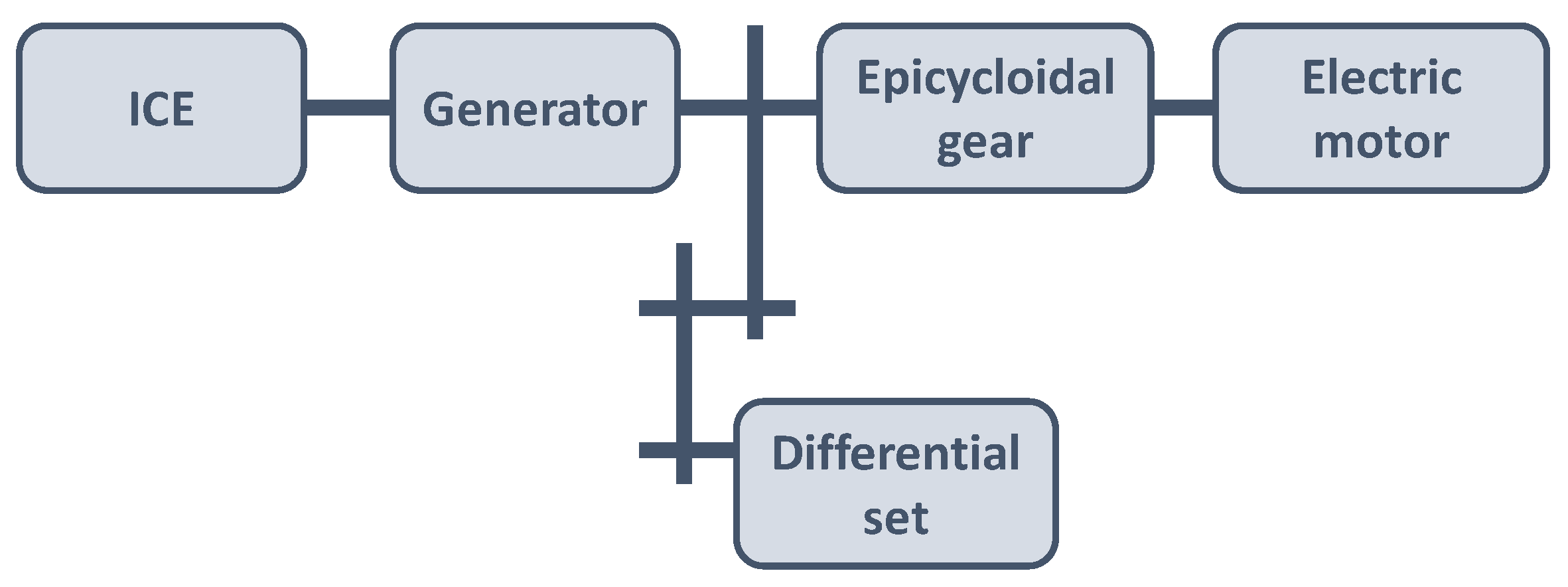
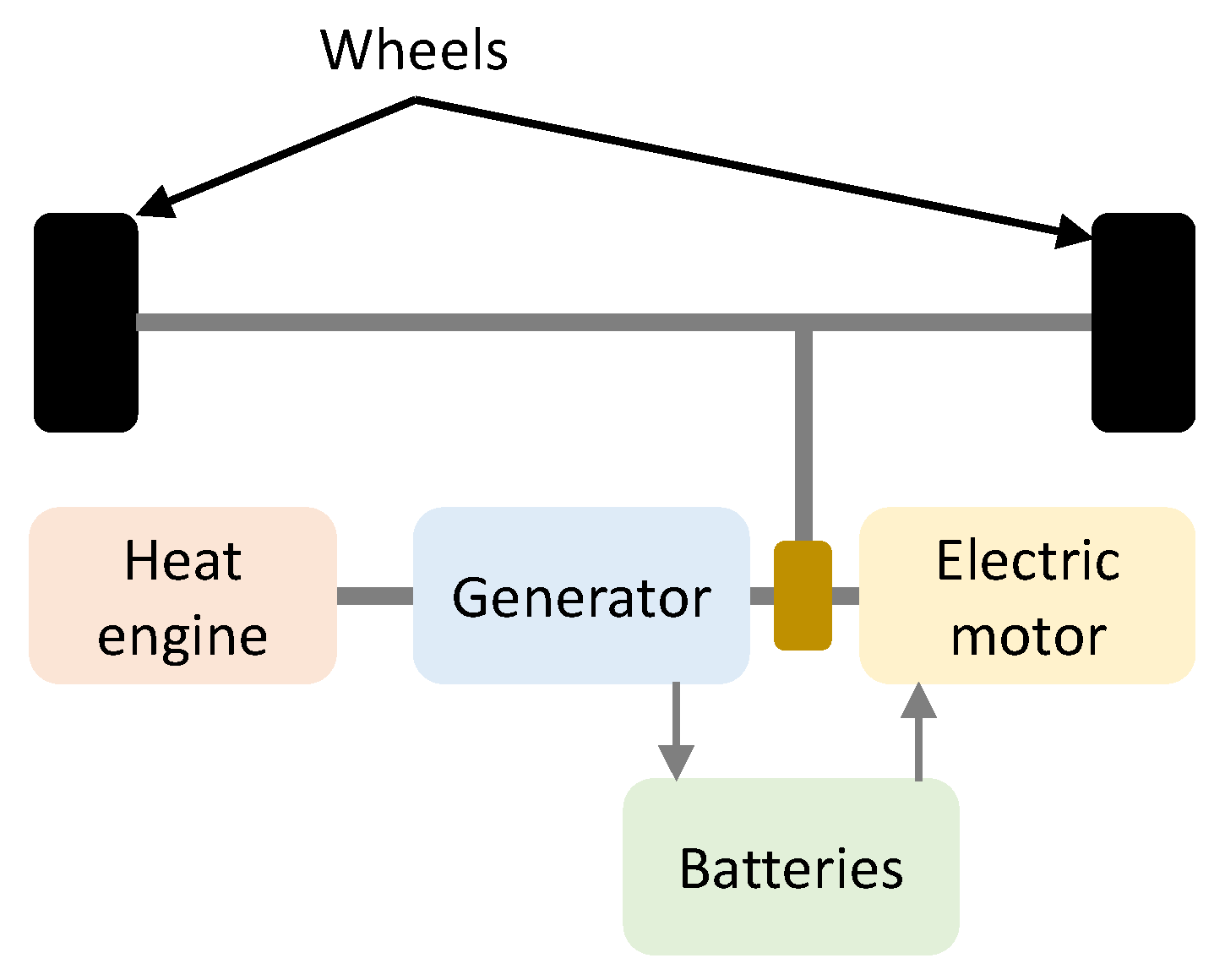
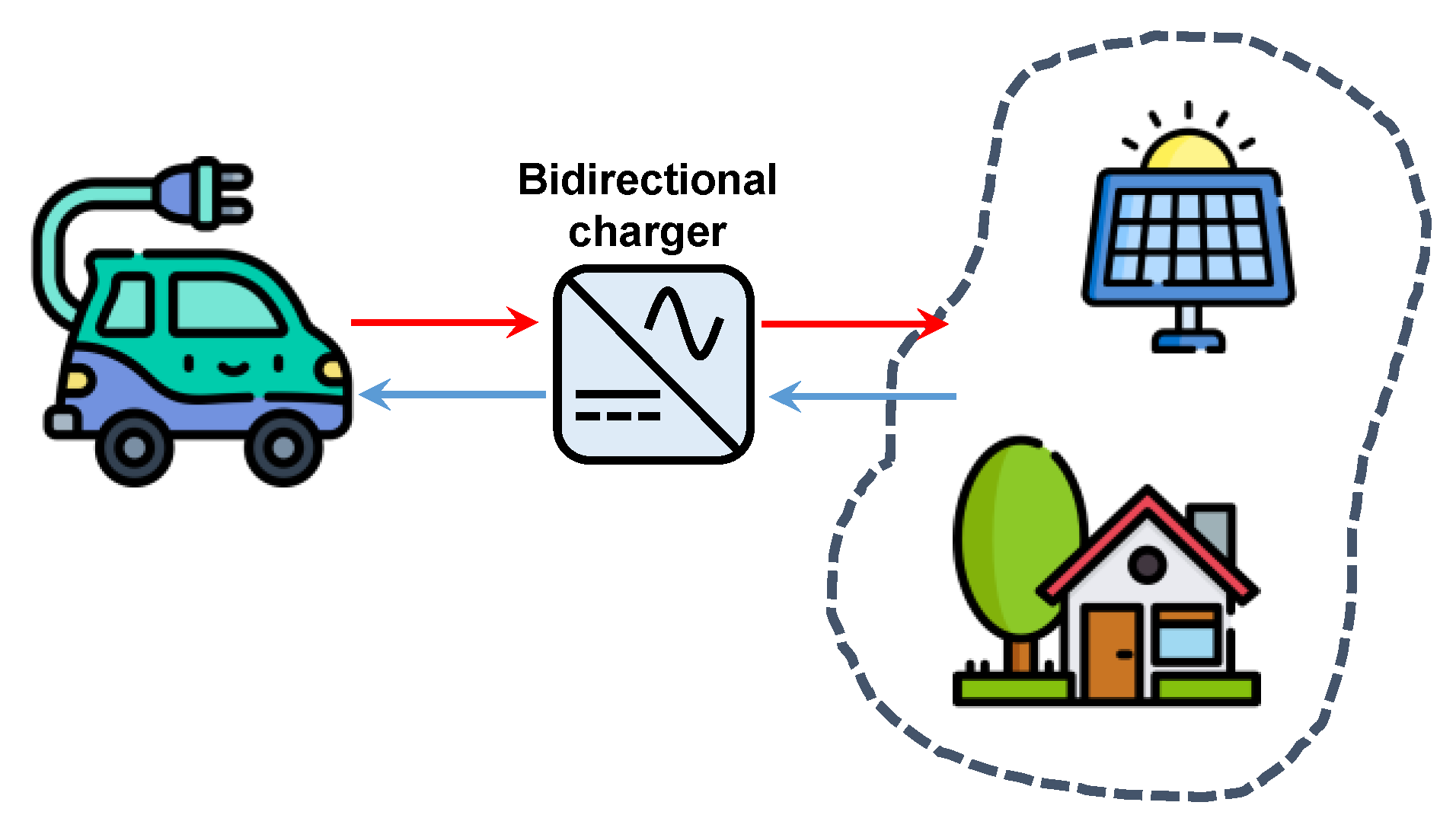
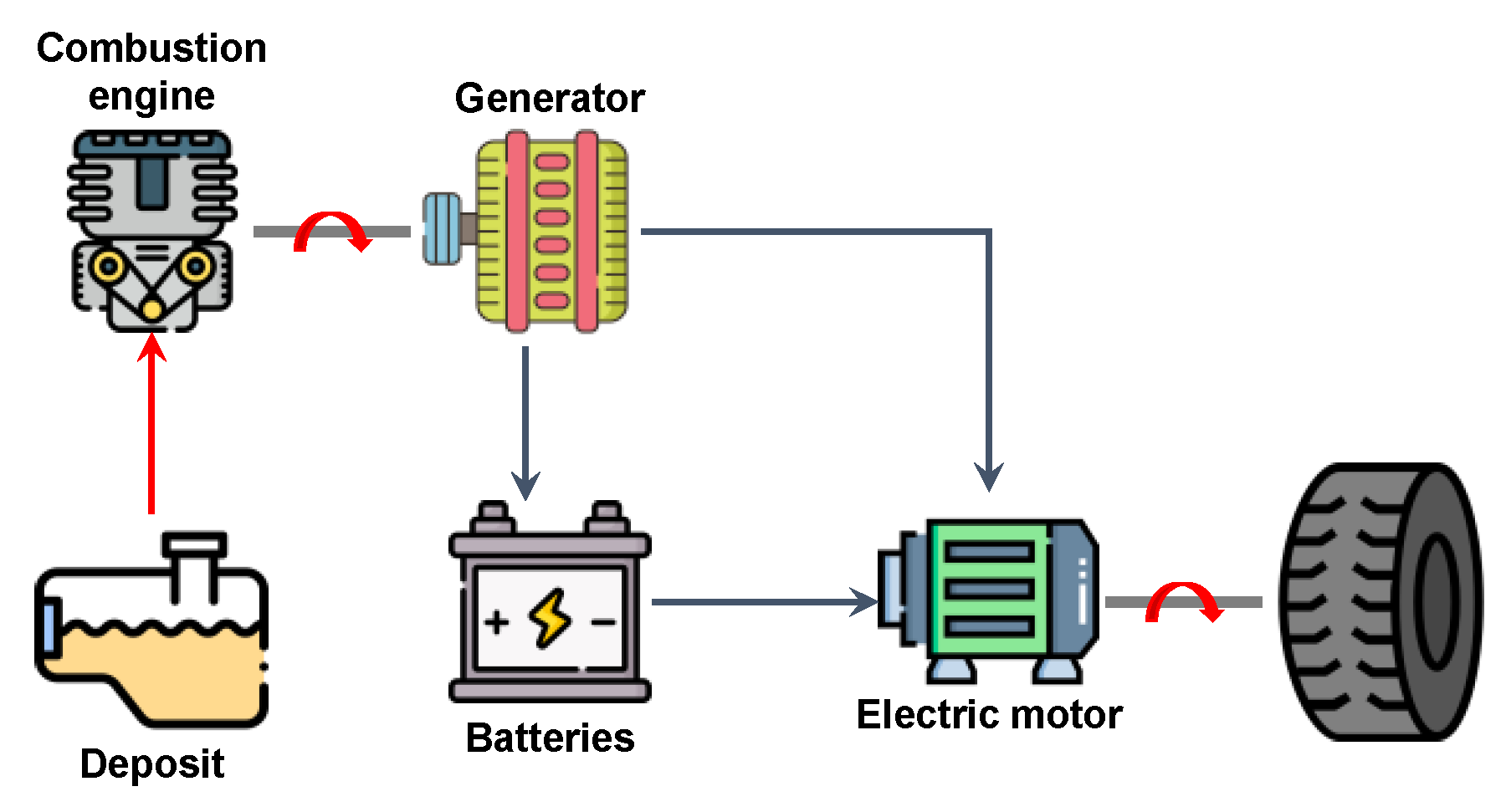

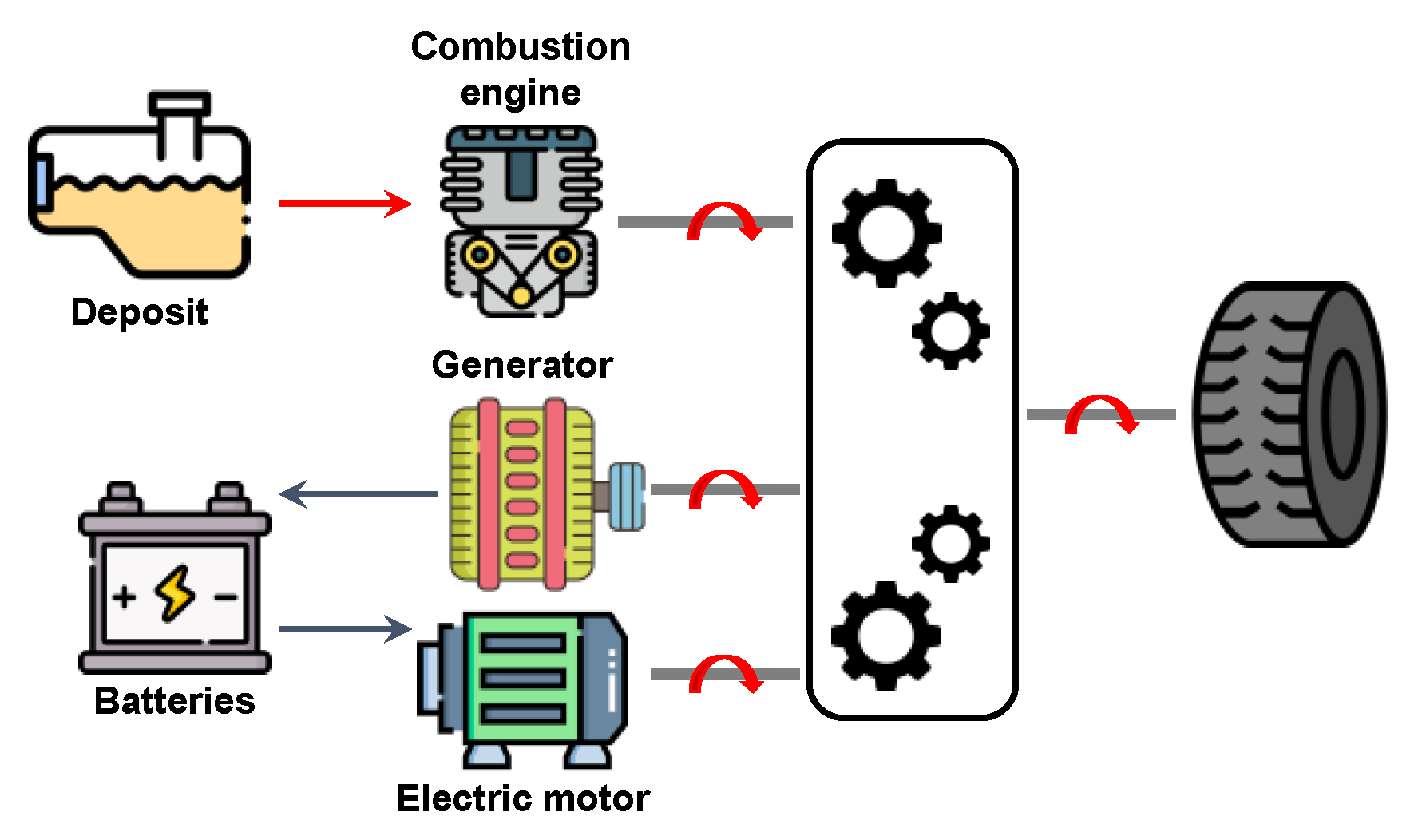
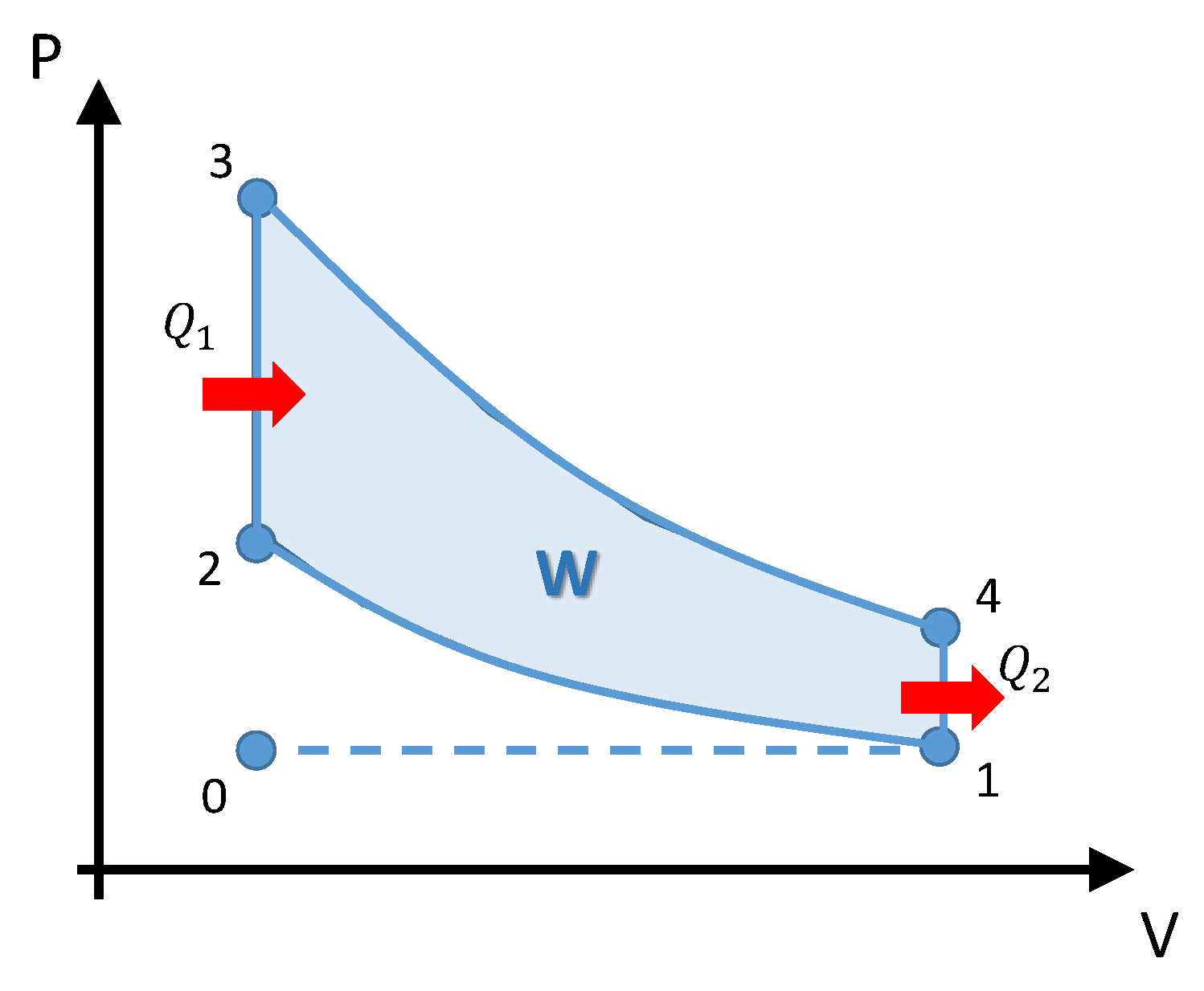

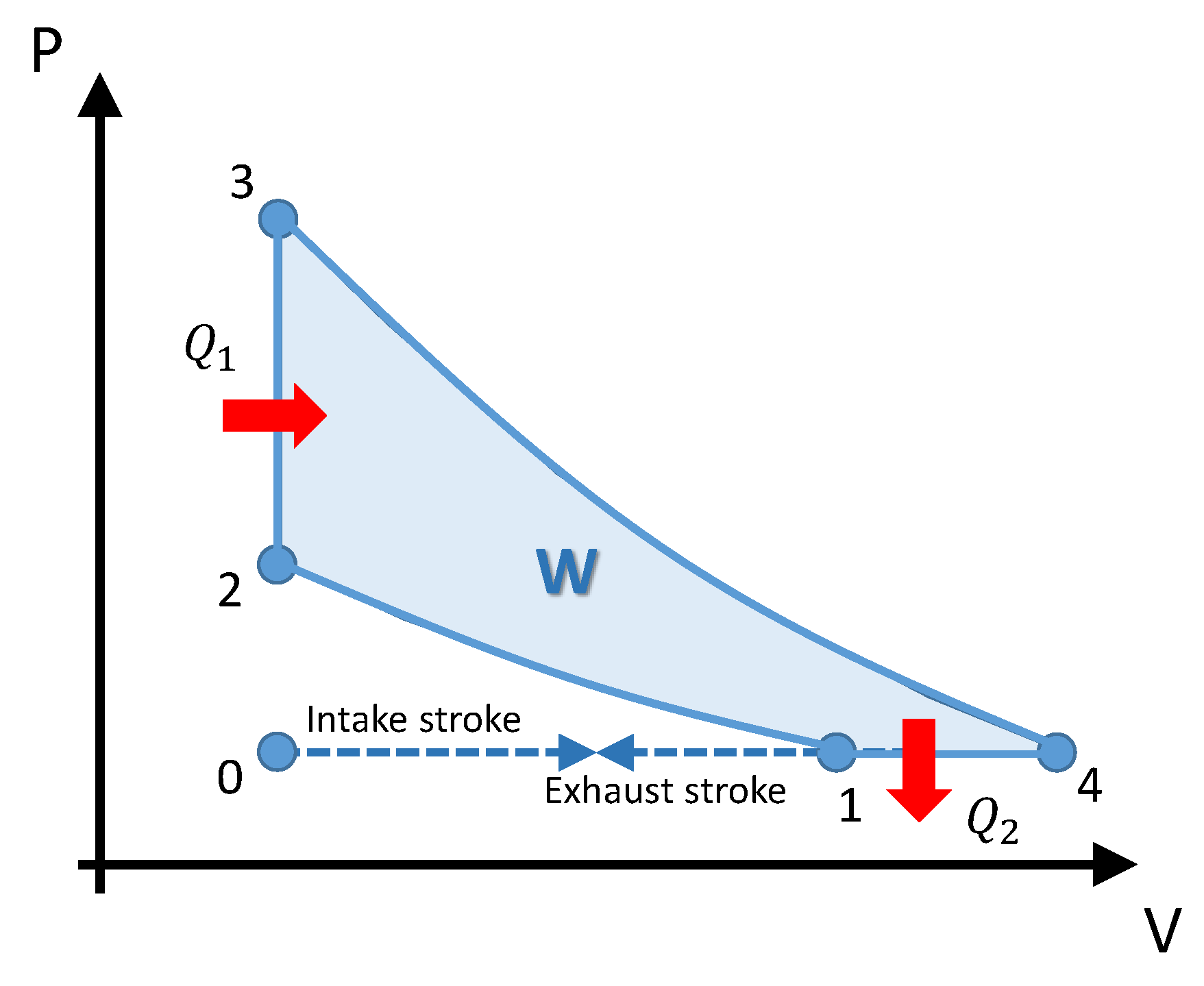
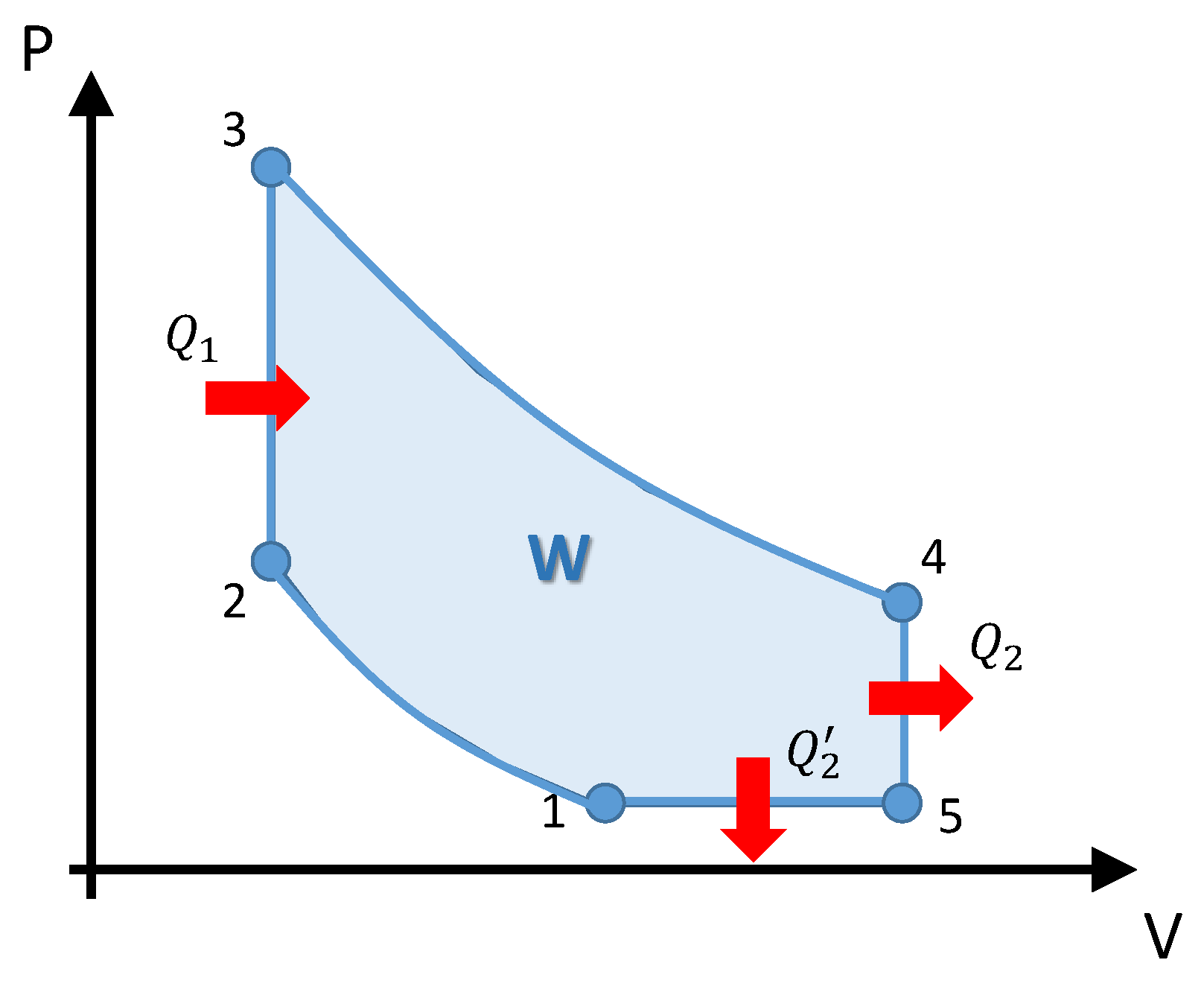
| Fuel | Driving Range (km) | Annual Fuel Cost (USD) | |
|---|---|---|---|
| Compact and Small | Mid and Large | ||
| All electric | 94–360 | 320–650 | 600–950 |
| Plug-in hybrid | 500–800 | 480–1000 | 750–2800 |
| Fuel cell electric | 570 | 600 | NA |
| Ethanol | 450–660 | 480–860 | 1900–2900 |
| Vehicle Model | Electric Autonomy (km) | Batteries | Type |
|---|---|---|---|
| Mercedes Class A 250e | 77 | Li-ion 15.6 | Plug-in |
| Toyota RAV4 Plug-in Hybrid | 75 | Li-ion 18.1 | Plug-in |
| Suzuki Across | 75 | Li-ion 18.1 | Plug-in |
| Volkswagen Golf eHybrid | 71 | Li-ion 13.0 kWh | Plug-in |
| Mercedes B 250 e | 70 | Li-ion 15.6 kWh | Plug-in |
| Mercedes CLA 250 e | 69 | Li-ion 15.6 kWh | Plug-in |
| Range Rover Evoque P300e | 66 | Li-ion 15.0 kWh | Plug-in |
| Fuel/Technology | Energy Density (MJ/kg) |
|---|---|
| Gasoline | 45 |
| Diesel | 45 |
| Hydrogen | 120 |
| Lead-Acid | 0.11–0.18 |
| Li-ion | 0.54–1.08 |
| NiCd | 0.11–1.26 |
| Architecture | Advantages | Disadvantages |
|---|---|---|
| Series |
|
|
| Parallel |
|
|
| Mixed |
|
|
Publisher’s Note: MDPI stays neutral with regard to jurisdictional claims in published maps and institutional affiliations. |
© 2021 by the authors. Licensee MDPI, Basel, Switzerland. This article is an open access article distributed under the terms and conditions of the Creative Commons Attribution (CC BY) license (https://creativecommons.org/licenses/by/4.0/).
Share and Cite
León, R.; Montaleza, C.; Maldonado, J.L.; Tostado-Véliz, M.; Jurado, F. Hybrid Electric Vehicles: A Review of Existing Configurations and Thermodynamic Cycles. Thermo 2021, 1, 134-150. https://doi.org/10.3390/thermo1020010
León R, Montaleza C, Maldonado JL, Tostado-Véliz M, Jurado F. Hybrid Electric Vehicles: A Review of Existing Configurations and Thermodynamic Cycles. Thermo. 2021; 1(2):134-150. https://doi.org/10.3390/thermo1020010
Chicago/Turabian StyleLeón, Rogelio, Christian Montaleza, José Luis Maldonado, Marcos Tostado-Véliz, and Francisco Jurado. 2021. "Hybrid Electric Vehicles: A Review of Existing Configurations and Thermodynamic Cycles" Thermo 1, no. 2: 134-150. https://doi.org/10.3390/thermo1020010
APA StyleLeón, R., Montaleza, C., Maldonado, J. L., Tostado-Véliz, M., & Jurado, F. (2021). Hybrid Electric Vehicles: A Review of Existing Configurations and Thermodynamic Cycles. Thermo, 1(2), 134-150. https://doi.org/10.3390/thermo1020010










